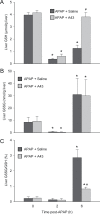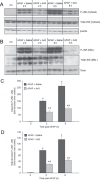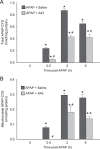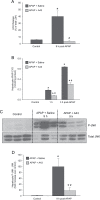Purinergic receptor antagonist A438079 protects against acetaminophen-induced liver injury by inhibiting p450 isoenzymes, not by inflammasome activation
- PMID: 22986947
- PMCID: PMC3537131
- DOI: 10.1093/toxsci/kfs283
Purinergic receptor antagonist A438079 protects against acetaminophen-induced liver injury by inhibiting p450 isoenzymes, not by inflammasome activation
Abstract
Acetaminophen (APAP) overdose is the most frequent cause of acute liver failure in the western world. Controversy exists regarding the hypothesis that the hepatocyte injury is amplified by a sterile inflammatory response, rather than being the result of intracellular mechanisms alone. A recent study suggested that the purinergic receptor antagonist A438079 protects against APAP-induced liver injury by preventing the activation of the Nalp3 inflammasome in Kupffer cells and thereby preventing inflammatory injury. To test the hypothesis that A438079 actually affects the intracellular signaling events in hepatocytes, C57Bl/6 mice were treated with APAP (300 mg/kg) and A438079 (80 mg/kg) or saline and GSH depletion, protein adduct formation, c-jun-N-terminal kinase (JNK) activation, oxidant stress, and liver cell necrosis were determined between 0 and 6 h after APAP administration. APAP caused rapid GSH depletion, extensive protein adduct formation in liver homogenates and in mitochondria, JNK phosphorylation and mitochondrial translocation of phospho-JNK within 2 h, oxidant stress, and extensive centrilobular necrosis at 6 h. A438079 significantly attenuated GSH depletion, which resulted in a 50% reduction of total liver and mitochondrial protein adducts and substantial reduction of JNK activation, mitochondrial P-JNK translocation, oxidant stress, and liver injury. The same results were obtained using primary mouse hepatocytes. A438079 did not directly affect JNK activation induced by tert-butyl hydroperoxide and GSH depletion. However, A438079 dose-dependently inhibited hepatic P450 enzyme activity. Thus, the protective effect of A438079 against APAP hepatotoxicity in vivo can be explained by its effect on metabolic activation and cell death pathways in hepatocytes without involvement of the Nalp3 inflammasome.
Figures







Similar articles
-
Editor's Highlight: Metformin Protects Against Acetaminophen Hepatotoxicity by Attenuation of Mitochondrial Oxidant Stress and Dysfunction.Toxicol Sci. 2016 Dec;154(2):214-226. doi: 10.1093/toxsci/kfw158. Epub 2016 Aug 25. Toxicol Sci. 2016. PMID: 27562556 Free PMC article.
-
4-Methylpyrazole protects against acetaminophen hepatotoxicity in mice and in primary human hepatocytes.Hum Exp Toxicol. 2018 Dec;37(12):1310-1322. doi: 10.1177/0960327118774902. Epub 2018 May 9. Hum Exp Toxicol. 2018. PMID: 29739258 Free PMC article.
-
The gap junction inhibitor 2-aminoethoxy-diphenyl-borate protects against acetaminophen hepatotoxicity by inhibiting cytochrome P450 enzymes and c-jun N-terminal kinase activation.Toxicol Appl Pharmacol. 2013 Dec 15;273(3):484-91. doi: 10.1016/j.taap.2013.09.010. Epub 2013 Sep 23. Toxicol Appl Pharmacol. 2013. PMID: 24070586 Free PMC article.
-
Pathophysiological significance of c-jun N-terminal kinase in acetaminophen hepatotoxicity.Expert Opin Drug Metab Toxicol. 2015;11(11):1769-79. doi: 10.1517/17425255.2015.1071353. Epub 2015 Jul 20. Expert Opin Drug Metab Toxicol. 2015. PMID: 26190663 Free PMC article. Review.
-
Current etiological comprehension and therapeutic targets of acetaminophen-induced hepatotoxicity.Pharmacol Res. 2020 Nov;161:105102. doi: 10.1016/j.phrs.2020.105102. Epub 2020 Jul 30. Pharmacol Res. 2020. PMID: 32738495 Review.
Cited by
-
Benzyl alcohol protects against acetaminophen hepatotoxicity by inhibiting cytochrome P450 enzymes but causes mitochondrial dysfunction and cell death at higher doses.Food Chem Toxicol. 2015 Dec;86:253-61. doi: 10.1016/j.fct.2015.10.016. Epub 2015 Oct 30. Food Chem Toxicol. 2015. PMID: 26522885 Free PMC article.
-
Study on the mechanism of hepatotoxicity of Aucklandiae radix through liver metabolomics and network pharmacology.Toxicol Res (Camb). 2024 Aug 7;13(4):tfae123. doi: 10.1093/toxres/tfae123. eCollection 2024 Aug. Toxicol Res (Camb). 2024. PMID: 39119266 Free PMC article.
-
Hepatitis C virus structural proteins can exacerbate or ameliorate acetaminophen-induced liver injury in mice.Arch Toxicol. 2015 May;89(5):773-83. doi: 10.1007/s00204-015-1498-5. Epub 2015 Mar 6. Arch Toxicol. 2015. PMID: 25743375 Free PMC article.
-
Xenobiotic and Endobiotic Mediated Interactions Between the Cytochrome P450 System and the Inflammatory Response in the Liver.Adv Pharmacol. 2015;74:131-61. doi: 10.1016/bs.apha.2015.04.001. Epub 2015 May 19. Adv Pharmacol. 2015. PMID: 26233906 Free PMC article. Review.
-
Animal models of drug-induced liver injury.Biochim Biophys Acta Mol Basis Dis. 2019 May 1;1865(5):1031-1039. doi: 10.1016/j.bbadis.2018.08.037. Epub 2018 Sep 3. Biochim Biophys Acta Mol Basis Dis. 2019. PMID: 31007174 Free PMC article. Review.
References
-
- Bajt M. L., Knight T. R., Lemasters J. J., Jaeschke H. (2004). Acetaminophen-induced oxidant stress and cell injury in cultured mouse hepatocytes: Protection by N-acetyl cysteine. Toxicol. Sci. 80, 343–349. - PubMed
-
- Bajt M. L., Lawson J. A., Vonderfecht S. L., Gujral J. S., Jaeschke H. (2000). Protection against Fas receptor-mediated apoptosis in hepatocytes and nonparenchymal cells by a caspase-8 inhibitor in vivo: Evidence for a postmitochondrial processing of caspase-8. Toxicol. Sci. 58, 109–117. - PubMed
-
- Buters J. T., Schiller C. D., Chou R. C. (1993). A highly sensitive tool for the assay of cytochrome P450 enzyme activity in rat, dog and man. Direct fluorescence monitoring of the deethylation of 7-ethoxy-4-trifluoromethylcoumarin. Biochem. Pharmacol. 46, 1577–1584. - PubMed
-
- Cohen S. D., Pumford N. R., Khairallah E. A., Boekelheide K., Pohl L. R., Amouzadeh H. R., Hinson J. A. (1997). Selective protein covalent binding and target organ toxicity. Toxicol. Appl. Pharmacol. 143, 1–12. - PubMed
Publication types
MeSH terms
Substances
Grants and funding
LinkOut - more resources
Full Text Sources
Medical
Research Materials
Miscellaneous

